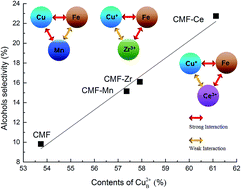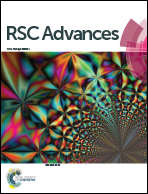Effects of metal promotion on CuMgFe catalysts derived from layered double hydroxides for higher alcohol synthesis via syngas
Abstract
Cu–Mg–Fe–M–O (M = Mn, Zr, and Ce) catalysts derived from layered double hydroxides (LDHs) precursors were prepared using a co-precipitation method and tested for higher alcohol synthesis (HAS) via carbon monoxide hydrogenation. The catalysts were subsequently characterized by N2-physisorption, X-ray diffraction (XRD), transmission electron microscopy (TEM), X-ray photoelectron spectroscopy (XPS) and H2 temperature-programed reduction (H2-TPR). The results show that Mn, Zr, and Ce promoters mainly contribute to the formation of tetrahedrally coordinated copper species, which favor the enhancement of the total alcohol selectivity. The addition of Mn facilitates the interaction between Cu and Fe, which causes the total alcohol selectivity and C2+ alcohol content in the total alcohols increased from 9.82% and 68.85% to 15.1% and 73.14%, respectively. However, the addition of Zr and Ce weakens the Cu–Fe interaction but increases the possibility of contact between Cu and Fe. As a consequence, the total alcohol selectivity is enhanced, while the C2+ alcohol content in the total alcohols is reduced upon Zr and Ce addition. Based on the characterization and catalytic results of the catalysts, a triple-active-site model is proposed to explain the different promoting effects of the three additives.


 Please wait while we load your content...
Please wait while we load your content...